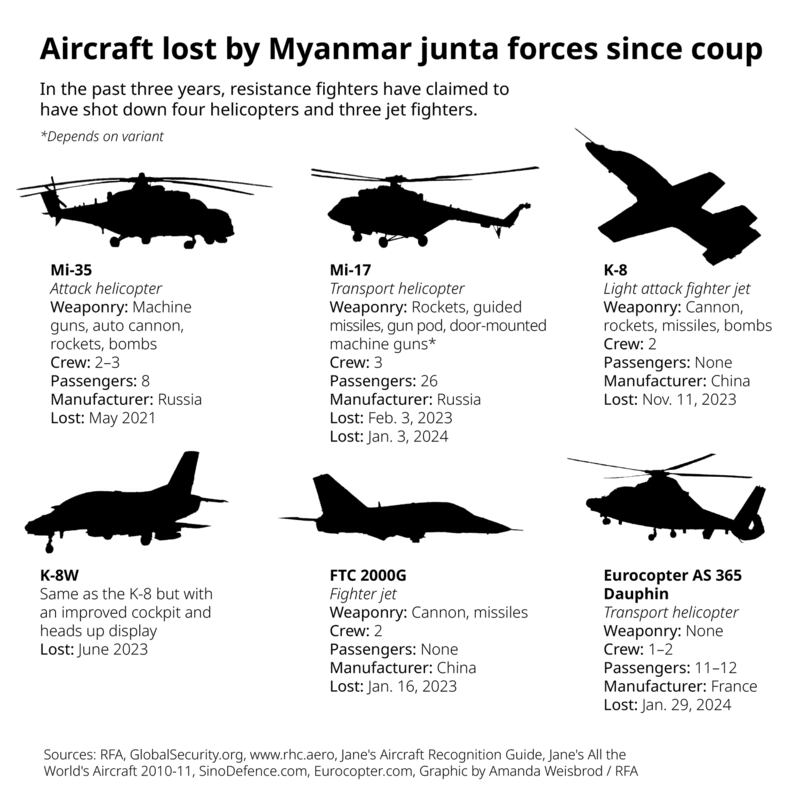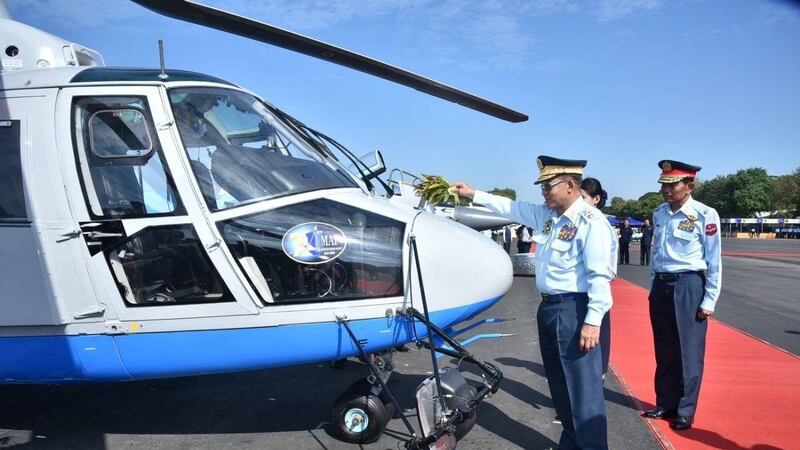Since Myanmar’s coup three years ago, anti-junta forces claim to have shot down at least seven military fighter jets and helicopters – three in January alone – a serious blow to the military increasingly relying on its advantage in the air against underequipped rebel groups making gains on the ground.
Radio Free Asia was unable to verify the shoot-downs, which rebels groups say were achieved mostly through small-arms fire. The military has said nothing about them.
Nearly all the incidents occurred within the past year, and three since the start of the year.
In the latest, on Jan. 29, a Eurocopter AS 365 Dauphin transport helicopter crashed in Kayin state’s Myawaddy township. Joint forces of the ethnic Karen National Liberation Army, or KNLA, and the Cobra People’s Defense Force, or PDF – ordinary citizens who have taken up arms – claimed responsibility for bringing it down.
On Jan. 3, the ethnic Kachin Independence Army, or KIA, claimed to have shot down a Mi-17 transport helicopter over Kachin state’s Waingmaw township, as well as a FTC 2000G fighter jet over northern Shan state on Jan. 16.
The military has become wary after losing fighter jets and combat helicopters in recent months, said KIA information officer Col. Naw Bu, and is now exclusively using transport helicopters “capable of carrying hundreds of bombs” in its attacks on rebel forces.
“But they cannot use helicopters everywhere,” he said. “That’s why … they are experiencing difficulties.”
A former army officer, who spoke on condition of anonymity due to security concerns, said that while anti-junta forces do not possess surface-to-air missiles and other sophisticated equipment, they are still capable of shooting down the junta’s low-flying aircraft with weapons such as .50 caliber machine guns.
“Speaking of the plane that went down recently, the ground commander couldn’t clear [anti-junta forces from] the ground, so the aircraft may have been shot down by snipers,” he said.
The officer noted that the United States military lost more than 2,200 aircraft during flights over Vietnam, Laos and Cambodia during the Vietnam War, including more than 1,700 to hostile action and more than 500 in accidents, despite having a significant advantage in the air over its enemies.
“Such things happen,” he said. “It can be said that these are common incidents.”
Pivot to the air
The junta, which ousted the democratically elected government in a Feb. 1, 2021 coup d’etat, has deployed fighter aircraft and artillery attacks in the ensuing civil war with devastating effect, in many cases causing civilian deaths and widespread destruction.
And as the rebel groups have seized more ground in recent months, junta commanders have increasingly turned to air attacks, opposition groups and military experts say.
During the first year of the coup, 109 civilians were killed and 177 were injured by airstrikes and artillery attacks. During the second year, civilian casualties jumped almost four times to 328 killed and 768 injured. The most recent year – between Feb. 1, 2023, and Jan. 31, 2024 – 992 people were killed and 1,696 were injured, according to data compiled by RFA.
U.N. High Commissioner for Human Rights Volker Turk warned earlier this week that human rights abuses in Myanmar had “deteriorated even further” in recent months as the military has grown desperate amid a series of battlefield defeats, and called for sanctions to limit the junta’s access to weapons, jet fuel, and foreign currency.

The first time rebels say they shot down a junta aircraft was in May 2021, just months after the coup, when the KIA claimed responsibility for taking out an Mi-35 attack helicopter that crashed in Kachin state’s Momauk township.
It would be nearly two years until the next crash, when a PDF paramilitary group in Sagaing region’s Homalin township claimed to have shot down a Russian-made Mi-17 transport helicopter on Feb. 3, 2023.
In June that year, the Karenni National People’s Liberation Front, or KNPLF, said it shot down a K-8W light attack fighter jet over Kayah state’s Bawlake township. Ethnic Karenni combined forces said they downed another K-8 fighter jet on Nov. 11 and were able to locate the crash site.
‘Generals’ blood run cold’
As the war drags into the fourth year, the military will lose more aircraft, predicted Capt. Ze Thu Aung, who left Myanmar’s Air Force to advise anti-junta groups as part of the Civil Disobedience Movement.
“Every resistance group now has an understanding of how to weaken the junta’s airstrikes,” he said. “At the moment, everyone is already preparing for them. That’s why the rate of military aircraft crashes has increased in 2023 and 2024.”
Than Soe Naing, a political commentator, said he believes that if more aircraft are destroyed, the military will lose its biggest asset, leading to “a turning point in protecting the lives of the people.”

More importantly, commentator Kyee Myint said, if the military’s aircraft is shown to be susceptible to attack, it would mark a significant blow to the junta’s tactical advantage over the armed resistance.
“It would make the generals’ blood run cold,” he said. “Then, the resistance would no longer need to look up in fear.”
Kawlin under attack
The latest crash came amid a fierce push by junta forces to retake Kawlin, in the northern Sagaing region, since the start of the month, with a combined force of some 800 soldiers supported by airstrikes, shelling and drone attacks.
Residents said that the military had recently dropped a column of reinforcements by aircraft to assist in its fight for the town – a rice-producing area of economic and strategic significance to northern Sagaing.
“Everyone is afraid of both the ground troops and aerial attacks,” said one resident who declined to be named, citing fear of reprisal.
Nearly 50,000 residents of Kawlin have fled the town since Feb. 1, after receiving reports of advancing troops and possible airstrikes, he said.
Translated by Htin Aung Kyaw and Aung Naing. Edited by Joshua Lipes and Malcolm Foster.

